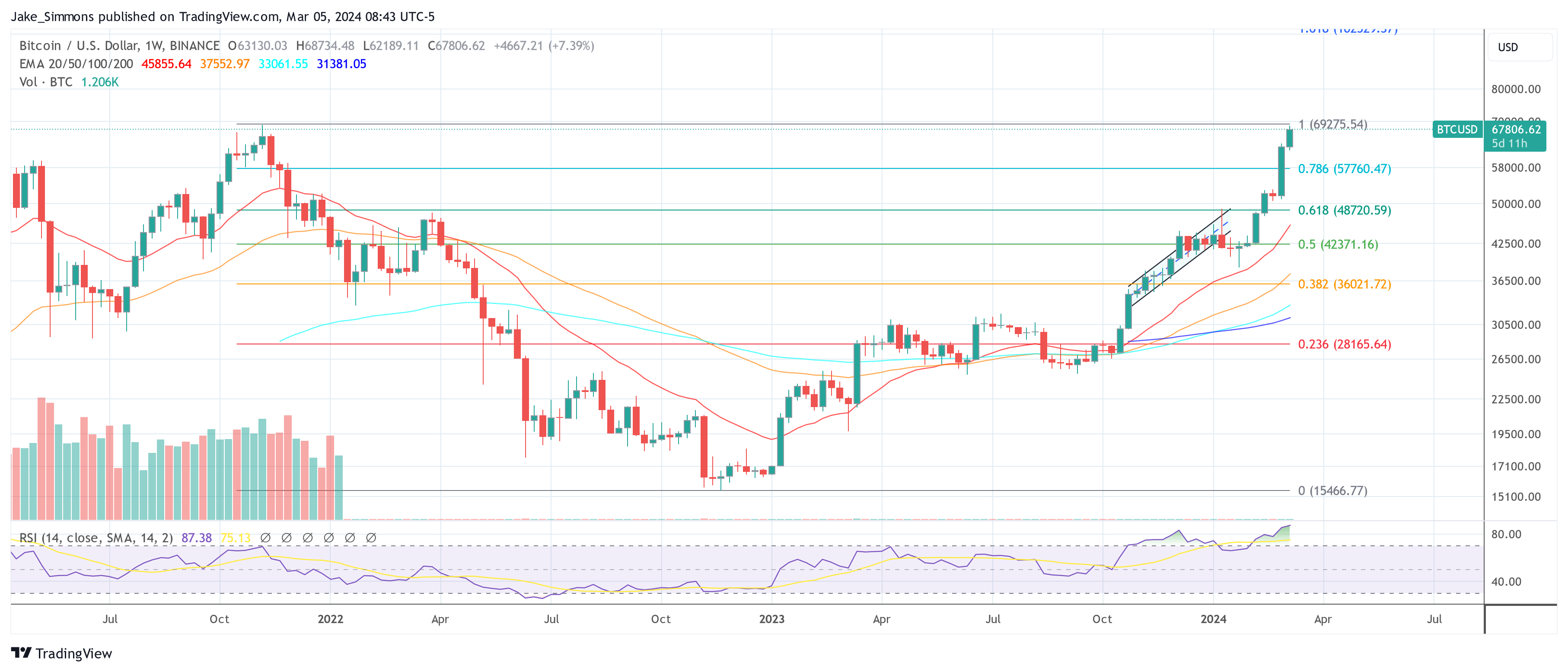Why A Bitcoin Supercycle Could Be Possible
First, he notes a significant shift towards Bitcoin ETFs by funds, including yesterday’s landmark announcement from Blackrock’s Strategic Income Opportunities Fund. This movement signifies a robust institutional interest that could feed a constant stream of investment into Bitcoin, setting the stage for a supercycle.“This will be a constant flow of new money into the ETFs. […] The flows into the ETF are getting bigger, not smaller,” van der Chijs remarked. With financial advisors poised to recommend Bitcoin ETFs to clients following a regulatory settling period, van der Chijs sees a torrent of new capital on the horizon. This anticipation is not unfounded, considering the groundbreaking success of the Bitcoin ETF launch, which he cites as “the most successful ETF launch ever.”
Corporate strategies around Bitcoin also play a pivotal role in van der Chijs’ supercycle theory. He points to Microstrategy’s aggressive leverage-based Bitcoin purchases as a harbinger of a trend where companies increasingly view Bitcoin not just as an investment, but as a fundamental aspect of their financial strategy. This shift, according to van der Chijs, could prompt other CEOs to follow suit, further accelerating Bitcoin’s ascendancy.
Moreover, a critical mass of financial advisors is on the brink of recommending Bitcoin ETFs to clients, pending the expiration of regulatory and due diligence waiting periods. This opens the gates for substantial new investments from a segment traditionally cautious about direct cryptocurrency investments. “They can’t sell the ETF during the first 90 working days (internal regulations mostly because of DD), although they are fast tracking it for this ETF,” van der Chijs stated.
FOMO And A Self-Fulfilling Prophecy
The speculation around unidentified large-scale Bitcoin acquisitions adds another layer to the supercycle narrative. Van der Chijs alludes to the intrigue surrounding a wallet that has been steadily accumulating Bitcoin, hinting at the involvement of a billionaire possibly akin to . “Since November 2023 a wallet has been adding on average about 100 BTC per day, the wallet now contains over 50,000 BTC,” he states, pointing to the potential for influential figures to catalyze broader market movements.Another argument is potential purchases by nation-states. Although nation-state involvement in Bitcoin has been minimal, with El Salvador being a notable example, any increase in such activities could trigger a domino effect. The participation of nation-states in the Bitcoin market could significantly elevate Bitcoin’s status as a sovereign asset class.
Macroeconomic Implications Of A Supercycle
Van der Chijs’ theory also touches on the potential macroeconomic implications of a Bitcoin supercycle, predicting a significant shift in wealth and power structures. The redistribution of wealth could see Bitcoin at the center of a new economic order, with traditional asset classes potentially losing ground. In conclusion, Marc van der Chijs outlines a compelling case for a forthcoming Bitcoin supercycle, supported by a confluence of institutional, corporate, speculative, and retail trends. He acknowledged the speculative nature of his prediction, “Right now I think there is a chance of maybe 10% that this will happen and that chance is (very slowly) going up.”However, the implications could be massive. “[I]t will change the existing world order. It will suck money out of the stock and bond markets, out of gold and other commodities, and even out of real estate (global housing prices could collapse). This will lead to BTC prices that we can’t even imagine today, potentially millions of dollars per BTC.”
At press time, BTC traded at $67,806.














